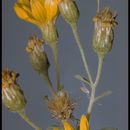Comments
provided by eFloras
Heterotheca viscida grows in the mountains of southeastern Arizona, southwestern New Mexico, and trans-Pecos Texas. Plants from Texas generally have oblanceolate leaves and smaller heads and can be similar to forms of H. fulcrata var. arizonica and var. senilis. The species typically blooms earlier in the season than H. fulcrata.
- license
- cc-by-nc-sa-3.0
- copyright
- Missouri Botanical Garden, 4344 Shaw Boulevard, St. Louis, MO, 63110 USA
Description
provided by eFloras
Perennials, 13–42 cm; taprooted. Stems 1–15+, ascending-erect (sometimes brown), appressed-strigose, mostly proximally long-hirsute, moderately to densely stipitate-glandular. Leaves: proximal cauline petiolate, blades ovate to oblanceolate, 23–51 × 5–15 mm, bases cuneate, margins entire, hispido-strigoso-ciliate (a few much longer spreading cilia near bases), apices acute to obtuse, mucronate, faces sparsely hispido-strigose, moderately to densely stipitate-glandular; distal sessile, blades lanceolate to ovate, 10–30 × 5–12.5 mm (sometimes slightly clasping, less so distally), margins flat or only remotely undulate, apices obtuse to acute. Heads 1–7, borne singly or in open, corymbiform arrays. Peduncles 10–36 mm, sparsely to moderately hispid, moderately to densely stipitate-glandular; bracts 0–2, linear-oblanceolate, usually greatly reduced. Involucres campanulate to hemispheric, 7.5–11 mm. Phyllaries in 4–5 series, lanceolate, unequal (outer lengths 1 / 5 – 1 / 4 inner), margins sometimes anthocyanic apically, faces sparsely strigose, stipitate-glandular. Ray florets 9–20; laminae 10–13 × 0.7–2.5 mm. Disc florets 16–76(–98); corollas ± ampliate, 5–7.5 mm, lobes 0.5–0.75 mm, sparsely hairy (0–0.25 mm). Cypselae monomorphic, obconic, compressed, 1.6–2.5 mm, ribs 4–7, faces moderately strigose; pappi off-white, outer of linear scales 0.2–1 mm, inner of 25–40 bristles 5–7 mm, longest weakly clavate. 2n = 18.
- license
- cc-by-nc-sa-3.0
- copyright
- Missouri Botanical Garden, 4344 Shaw Boulevard, St. Louis, MO, 63110 USA
Synonym
provided by eFloras
Chrysopsis villosa (Pursh) Nuttall ex de Candolle var. viscida A. Gray in A. Gray et al., Syn. Fl. N. Amer. 1(2): 123. 1884; C. viscida (A. Gray) Greene
- license
- cc-by-nc-sa-3.0
- copyright
- Missouri Botanical Garden, 4344 Shaw Boulevard, St. Louis, MO, 63110 USA
Heterotheca viscida: Brief Summary
provided by wikipedia EN
Heterotheca viscida, called the cliff goldenaster, is a North American species of flowering plant in the family Asteraceae. It grows on cliffs and ledges in mountainous regions. It grows in the southwestern United States, primarily in Arizona, New Mexico and southern Texas with reports of isolated populations in Nevada, southeastern Idaho, and southeastern Colorado.
- license
- cc-by-sa-3.0
- copyright
- Wikipedia authors and editors

